Magnificent Gloxinia is not in vain are considered one of the most favorite domestic flowers, because the appearance and painting of their buds are simply amazed with their beauty. In this article we describe the most common varieties of culture, we will tell about the rules of growing Gloxinia and the care of them.
Brief description of the plant and its main types
Gloxinia appeared in Europe about 3 centuries ago, where they were delivered from the countries of South America. Flowers quickly loved by many for the Pestry and a variety of color, long bloom and the ability to exude a pleasant fragrance. Most cultural varieties are perennial herbaceous plants or semi-stamps, blooming, as a rule, in a tropical climate. Buds on the reprehensive stems are located singly, in the form of flowers resemble bells painted in a wide variety of shades.
In our country, Gloxinia is used primarily as indoor plants, sometimes they can also be found in closed greenhouses. Due to the warmness, the flowers are not planted on the flower beds in the open air.
Depending on the external characteristics, the culture is divided into several types. For example, if we classify the gloxinia by how many rows, petals on buds grow on buds, 2 types of colors are distinguished: simple and terry. Simple gloxy petals are located in 1 row, terry buds have several rows of petals.
Plants can also be divided into several varieties depending on their color. So, there are gloxinia monophonic, stem and tigrines. The entire surface of one-photon buds has the same shade, the presence of a light core is allowed. Sitzine Gloxinia have small clips or peas of approximately one diameter on their petals. Gloxy-Tigrin flowers are also covered with scarves, but at the edges of the petals additionally there is a contrasting border.
If you classify the culture in the form of its inflorescences, then the bells and cue can be distinguished. The second title name - shoes. In shape, they resemble the bells, but are more elongated at the base.
Depending on the size of the rosette of the leaves, the culture is divided into 3 types: miniature, semi-minimular and standard gloccia. In miniature plants the diameter of the socket does not exceed 20 cm, semi-minimular bushes have a size of 20-30 cm in diameter, standard gloxinia is distinguished by a socket, the size of which is more than 30 cm. In principle, the size of the bush depends not only on the variety, but also on what Culture grows conditions.
Popular Gloxy Sorts
Gloxini varities There are many, but fans of indoor plants prefer to grow several of the most common varieties. The popularity of these varieties is primarily due to their high decorativeness. So, let's consider the distinctive features of famous types of Gloxin:
- Gloxinia "Cleopatra" rightfully occupies the first place among the favorite varieties of culture. This variety is the subject of selection, as a result of which the flower of unsurpassed beauty was obtained. Large Cleopatra's Machi Buds have beautiful wavy edges, and the white background of petals densely littered with contrasting small spots of dark purple, burgundy or lilac shade. Closer to the core of the strap flower merge into a single dark background. The bush of this variety is low and compact, the flowering is quite long and abundant.
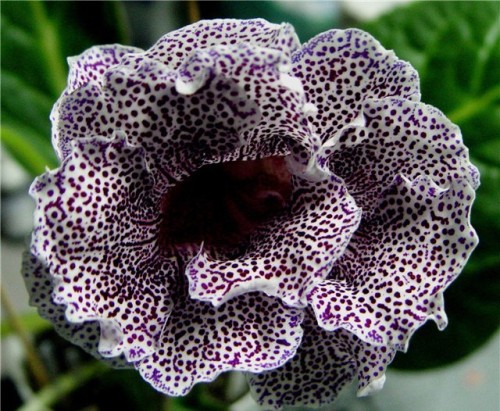
- Gloxinia "Brockada" is a varietary mixture represented by several shades of buds. The most popular colors are considered dark blue and red. There is also gloxy pink shade, decorated along the edge of a bright border. The lowered and compact bush of this culture blooms very abundantly, releasing about 25 major terry inflores during the season. Large size of buds looks profitable on the background of a small outlet.
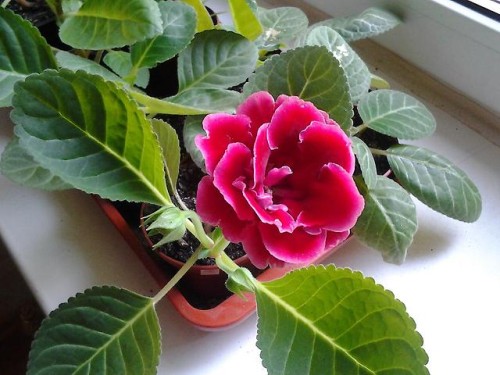
- Glocking Grade "Kaiser Wilhelm" has large in diameter of terry buds, painted in very dark blue or purple color. On the edge of the petals there is a white edging, which further emphasizes the shade of the flower. The surface of the petals is parceled, velvet. The gloxinia of this variety is blooming only for 3-4 years after landing, during flowering the bush is covered by a variety of large spectacular buds.
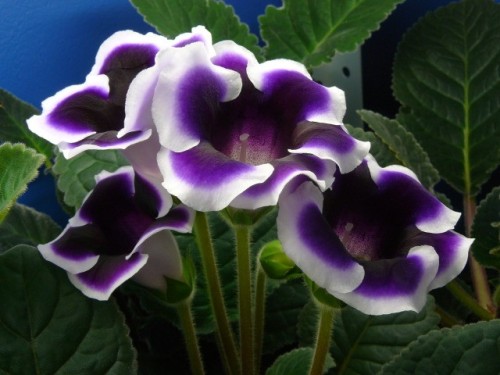
- Gloxinia "Kaizer Friedrich" is very similar to the previous variety, but differs from him burgundy coloring of petals.
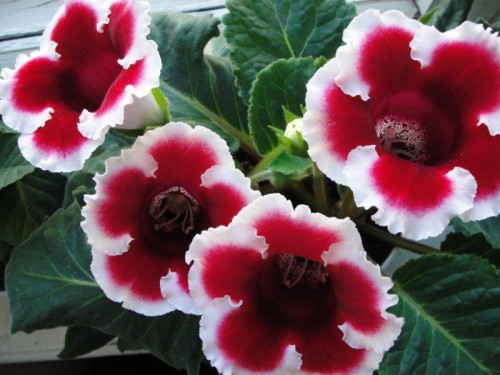
- Very effectively looks like a Gloxy "Winter Cherry". These flowers are reminded by their appearance to Gloxinia "Cleopatra", on a white background of petals there is a thick paint spots of a dark burgundy shade.
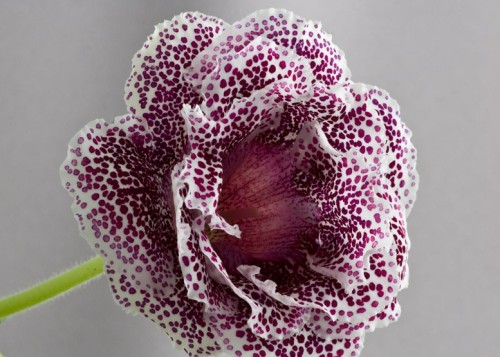
- Gloxinia "Eliza" is large flowers with velvety petals decorated along the edge of a dark blue or black and purple border. In the center of the buds there is a white field, covered with dark clips.
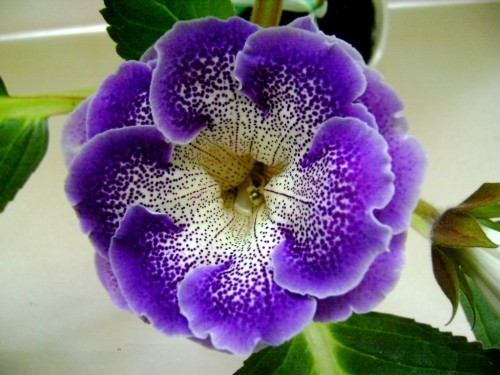
Gloxinia: Methods of breeding
Gloxinia belongs to those cultures that can be multiplied by several ways, and there should be a lot of ways to note. Flowers are traditionally bred by seeds, tubers, cuttings, as well as parts of leafy plates and flowering segments. The choice of method depends on what kind of grade you are going to transplant and what final result is awaiting. For example, species cultures are comfortable to multiply by seeds, so as not to get a lot of new young plants. But if you are going to transplant hybrid varieties and want to preserve their varietal signs, it is better to resort to one of the vegetative ways. Consider in more detail the features of the reproduction of Gloxy.
Planting seed flowers
Before growing gloxy from seeds, you need to collect sowing material. When the bush will release buds, wait for their dissolve and on the second day, spend the pollination procedure. With the help of a small soft bruster, carefully remove the pollen from the stamens and move it on the pestle stil. The next day, do the same again. In the case of successful pollination of the flower, in a few days, the perianth is outstanding, and in its place the maritime is formed. The fetus will gradually increase in size, seeds in it will be internally about 1.5-2 months. When the ripening process comes to an end, the box will burst and it will be possible to extract seeds. To do this, take a sheet of paper, substitute it under the revealed fruit and knock on the stalk. All mature seeds will fall on paper, and the rest will stay to dive, their collection can be made in a few days.
Sowing material has a good germination that preserves within 2-3 years. As a rule, no more than 3 fruits ripen on one bush, but if you have a very young and insufficiently severe plant, it is better to cut off extra boxes and leave one.
Seeds of Gloxy sow into a container with wet ground, while not instilled in the ground, but just pouring from above and slightly pressed the palm. Then the soil is covered with film or glass and put in a warm, well-lit place. This procedure can be made from the last numbers of January to the second half of March. The temperature at which the seedlings will grow should be at least 24-26 ° C, then the first sprouts can be observed after a couple of weeks after sowing. If there is not enough heat in the room, then shoots may not appear earlier than 1-1.5 months. Care of the seedy is very simple: it is necessary to maintain the ground in a moistened state, prevent the freezing of sprouts, and also make them airbases, periodically removing the film or glass. When watering, it is better to use a pulverizer or pour fluid into the pallet of the tank, so as not to wash the jet of water of the branches from the soil.
You can peer seedlings for the first time after its germination. The shoots are transplanted into light soil, observing the distance between the sprouts in 2 cm. After another month, when 2 real leaves appear on the stems, they produce a second pickup and plant plants into separate cups. The seedlings continue to keep in a warm room, where the temperature does not fall below + 20 ° C. As a rule, after the second transfer of bushes begin to develop rapidly and grow.
Landing Gloxinia Strenkov
The vegetative reproduction of culture is used in the case when they want to preserve the varietal signs and the decorative type of hybrid plants. If we produce a similar planting in the spring, then in the current year, bushes will produce their first buds. Gloxiny's shilling can be carried out in two ways: planting leafy and stem cuttings. Consider these methods in more detail:
- Before planted with a glockey sheet, you need to cut off the suitable sheet at the bottom of the socket. This is done during the flowering season or during the formation of buds. The cuttings, if possible, should have a fairly large diameter - so you will get a strong tuber. When you choose a suitable fragment, put it in a shallow container with water so that it is immersed in a liquid of about 1-1.5 cm. In this form, leave the cuttings until the roots break on it. It is not necessary to change the water in the tank, and in the case of its evaporation, you can gradually add liquid. After the appearance of the roots, transfer the cuttings into the ground, in the depth of 2 cm, and then cover with a clean glass can or a dense film. There is another way to plant a stalk, at which it does not need to be pre-kept in water. The cut fragment must be dipped into the pounced charcoal and insert into the wet ground, and then cover the glass jar in the same way. Maintain the ambient temperature at + 22 ° C, and then the plant is rooted for 3 weeks, then the bank can be removed. If you wish to get 2 tubers from one leaf, divide the base of the cutter into 2 parts by a sharp knife, cutting it to a depth of 1.5 cm.
- In the event that a lot of lateral shoots were formed on the tubers of culture, it can be cut off, leaving only 1 or 2 sprouts developing. Cut items can be used to transplantation with steel stalks. To root them should be exactly the same as leafy cuttings.
Landing leaf plate
At the base of the outlet, choose a large sheet, cut it up, turn it over the bottom side to yourself and with the help of a sharp knife, make several transverse cuts in those places where the thick bodies are located. Put the sheet on a wet land, press a bit to the soil or sprinkle with a small amount of soil. Then cover the leaf with a glass jar or a durable film and put a container with the ground into a warm place. Support the temperature at + 22 ° C and follow so that the soil has always been well moistened. After time, the roots will warm the roots, which will then turn into tubers.
The leaf plate can be divided into several parts across, each fragment is put on a wet soil or sand, cover with a can and put it in greenhouse before rooting. The temperature in the greenhouse is better maintained at 22-25 ° C.
Dilution of Glocking Planting Floweros
Some individual varieties can be multiplied by a similar way, but, unfortunately, this method of transplant is not suitable for all types of Gloxin. If you decide to plant a culture with a color-seater, wait until the petals on the booton fade and fall, then cut the flowers and immerse it in a container with water to a depth of 1-1.5 cm. The flowers should not touch the walls of the container, water as evaporations need to be gradually . Put the vessel into a warm and well-lit place, about 30 days the bloomon will let the root. When this happens, remove the plant from the water and put in the ground, inserts to the depth of no more than 2 cm. Moisten, cover with a can and take care of the same way as behind the leaf cutter.
Glokoxinia care at home
When growing gloxy, it is important to take into account many factors: ambient temperature, degree of illumination, air humidity and soil, etc. The basic rules of culture care I would like to consider in detail:
- Gloxia refers to those plants that love good lighting and prefer to grow in a long daylight. So that the bushes of culture please you with large buds and long abundant blossoms, ensure Gloxy access to sunlight. But remember that the lighting should be scattered, because under the right rays of flower petals and leaves can get burns. It is advisable to put pots with gloxins on the windowsill with the southern and eastern sides of the house by creating the necessary protection from direct sunlight. If you grow a culture on the northern windows, it will stretch up and blossom. Another small secret: so that the bush was beautiful and evenly developed, it should be turned from time to time to the Sun with different sides.
- Gloxinia, who came to us from hot countries, do not like cold and grow well only warm. The optimal temperature for this plant is considered an indicator of 19-22 ° C, but during the transplantation and rooting of cherries and tubers the surrounding air should be somewhat warmer. To allow strong heat should not, because at temperatures above 28 ° C, the roots of the Gloxy are overheated, the bush ceases to grow and blooms very badly.
- Another condition of growing Gloxy is the right watering mode. In the season of flowering, as well as during active growth and development, the plant needs to ensure good humidity not only soil, but also ambient air. In case of insufficient humidity, foliage is deformed, and the buds fall and not expand. It is possible to achieve the desired result by spraying water around the plants with a spray gun. It is undesirable that the moisture drops hit the bush directly. Equally, it is also important to regularly water the colors under the root, trying not to affect the stalks, leaves and buds. Spraying and watering can be carried out only sufficiently warm water. Abundant moisturizing lasts until the end of the flowering season, approximately by the middle of the autumn, watering almost stops and the plant is preparing for the rest period.
- To avoid the risk of development on the colors of fungal diseases, the room with gloccia is often needed. By the way, the root system in such a plant is not very strong, thin roots in case of insufficient injection moisture are faded. Therefore, during irrigation, it is necessary to ensure that the water is evenly distributed over the entire surface of the soil.
- Gloxinia needs regular feeding. Facely bushes are allowed every week since April and ending with the first few days of August. Special compositions for flowering plants are suitable as feeding, in which there is a small amount of nitrogen and a high percentage of potassium and phosphorus. Nitrogen is responsible for increasing the green mass, which leads to a decrease in the number of buds and the deterioration of their decorative qualities. To feed the gloxia fertilizers and at the same time process them with fungicides cannot be categorically impossible, but fertilizers can be made to the ground together with substances that stimulate the growth of bushes. Note that watering high concentration fertilizers can lead to the formation of burns on the roots, so it is better to make a solution weaker and water the flowers more often. The feeding should not be made in the soil after the recent transplant of Gloxinia, as well as in the process of rooting the cuttings.
- It is also necessary to approach the choice of cultural culture tanks. Gloxinia has a branched root system located in the surface layer of soil. That is why wide, but shallow pots are suitable as dishes. Here you also need to pay attention to the size of the transplantable tuber. If the tuber is large, the distance between it and the walls of the container should be approximately 4-5 cm. For a small tuber, this indicator can be reduced to 3-4 cm.
- The soil for planting the Gloxy is desirable to pick up fertile and easy to use water and air well. The soil reaction should be weakly acid. The approximate composition of the soil looks like this: on 2 parts of the leaf land should have 1 part of the river sand and peat ground. In pots also need to provide good drainage.
- Gloxinia is able to bloom several times during the season, but for this you need to produce several simple actions. In May or June, when the first buds fell, the stem must be cut off to the level of 2-4 lower sheets. After a short time, steppes are formed in the sinuses, which also need to be removed, leaving 1-2 the strongest. Then the plant should be fertilized by special compositions for active growth for a month. After about 30 days, inflorescences will begin to appear on the stem, during this period you can switch to feeding, stimulating flowering.
- For Gloxy, as for a perennial plant, a long period of rest is characteristic. To this stage, culture must be prepared properly. After the complete end of flowering, which comes in the fall, watering bushes need to be reduced to a minimum and fertilize the plant is no more often than 1 time in 3 weeks. After fading the foliage, the stem can be cut off, leaving a short pasta to 2 cm high. Once in 2-4 weeks, the sand should be slightly moistened to prevent tuber drying. But it's not too much to water them, to avoid the appearance of rot. In January, you can transplant Gloxinia to a new, more nutritious soil.
Diseases and pests of Gloxy
- In case of incorrect watering tubers gloxinia may form rot, which is considerably during storage or transfer. If your plant has suffered from rot, scoop it out of the ground, wash with clean water, a knife, cut the affected areas, and sprinkle the cut with powdered charcoal. Leave the tubers in the open air for about 1 day, and then bury them in the ground, burying at 1/3 height.
- In the event that the rot was struck gloxinia stems, affected plants should be uprooted and destroyed.
- Noticing on the leaves brown stains culture, can be suspected infection gloxinia botrytis. Affected leaves need to break, and the bush sprayed with a solution of fungicide.
- Gloxinia are highly susceptible to the emergence of such unpleasant diseases such as late blight. The main manifestation of this disease is stem rot directly near its base.
- As for pests, then gloxinia dangerous caterpillars, thrips, nematodes, aphids and spider mites. Some insects are carriers of infectious diseases dangerous to the culture. It should be noted that in the case of gloxinia pest control can be carried out is not all insecticides. Some substances can be left on the tender leaves of plants severe burns.
Gloxinia, photo:

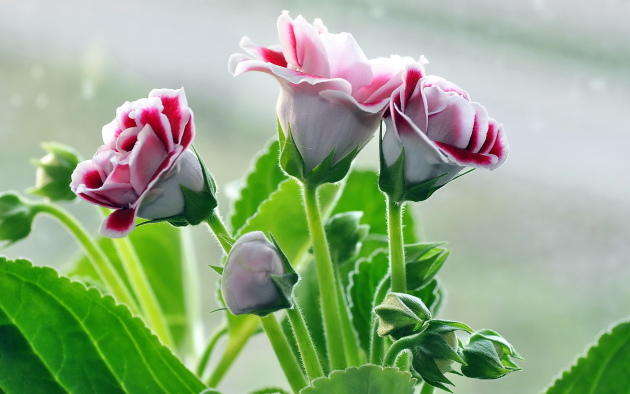
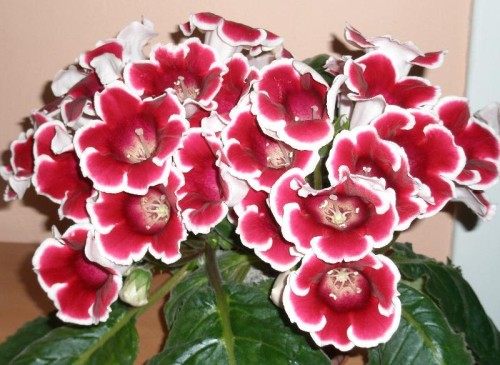
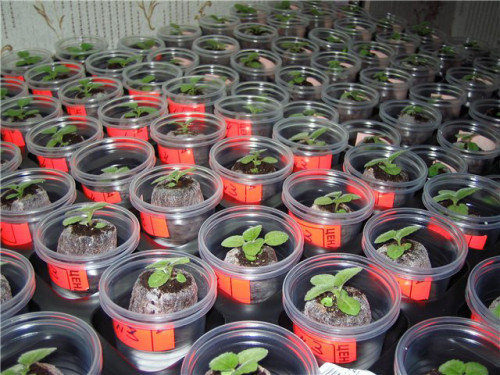
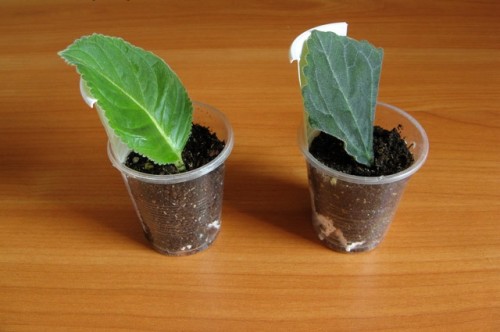
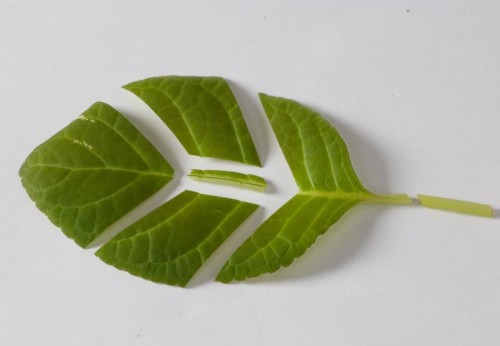
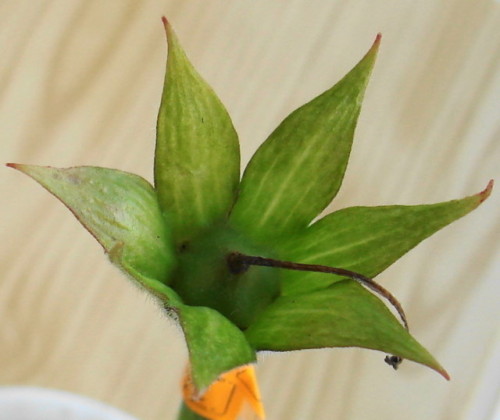
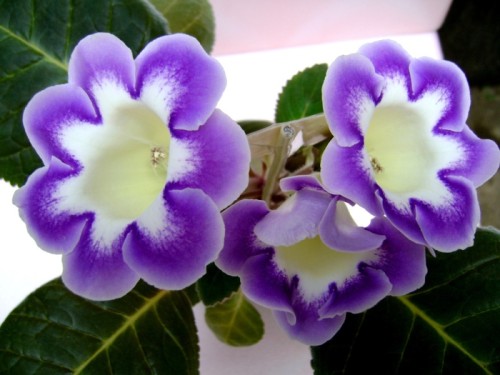
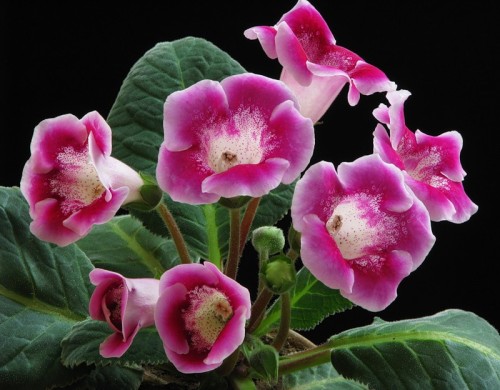
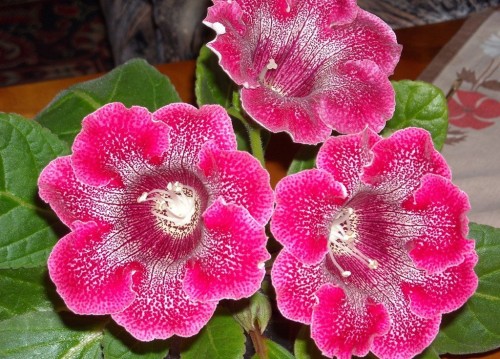
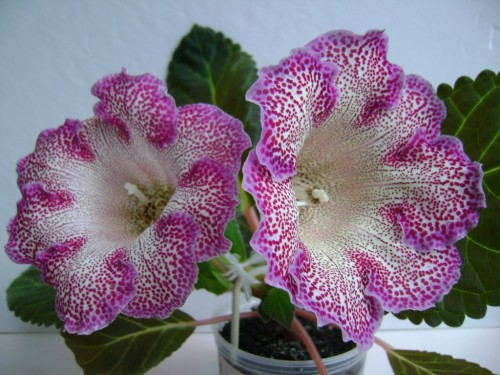

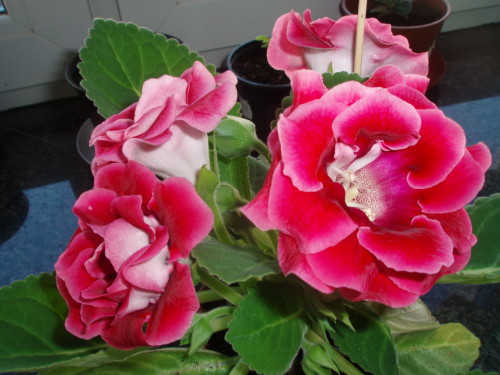
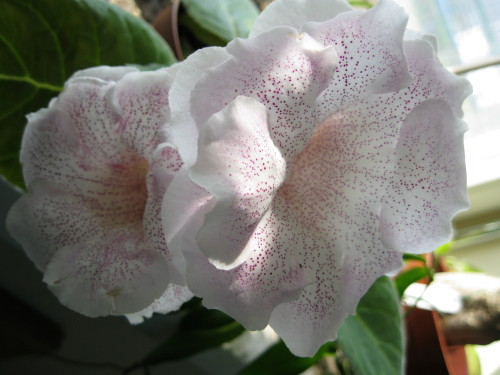
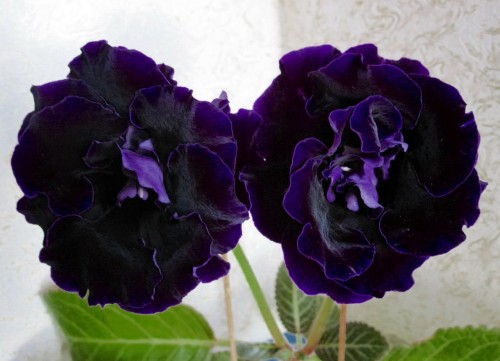
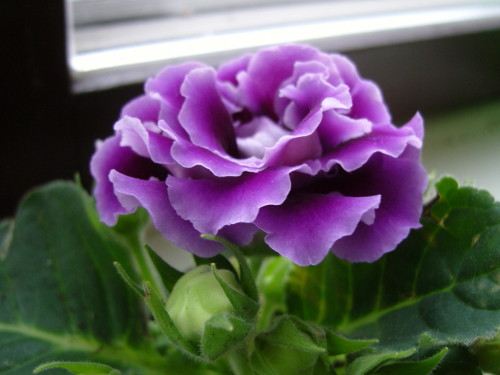












 Start a discussion ...
Start a discussion ...